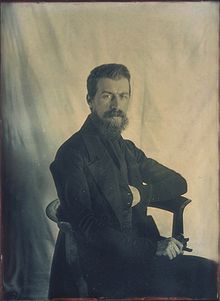Johann Baptist Isenring

Johann Baptist Isenring (born May 12, 1796 in Lütisburg ; † April 9, 1860 in St. Gallen ) was a Swiss landscape painter, printer and the first daguerreotypist in Switzerland.
Live and act
Johann Baptist Isenring completed an apprenticeship as a carpenter in Zurich . During his wanderings to Vienna and Munich (1816-17) he worked as a flat painter and gilder. Thanks to a scholarship from the Canton of St. Gallen, he was able to study landscape painting and aquatint at the Munich Art Academy in 1820 . In 1823 he returned to St. Gallen and self-published the 20- sheet aquatint series Thurgegenden from 1825-27 . He opened an art shop in St. Gallen in 1828 and began publishing his largest lithographic work in 1831, the collection of picturesque views of the strangest towns and places in Switzerland .
When he heard about the invention of the daguerreotype in 1839, he ordered a camera in Paris and thus became the first Swiss daguerreotype. In August 1840 he presented the world's first photographic exhibition in his studio with city views, reproductions of paintings and 38 portraits, for which he also had a four-page catalog printed. The exhibition was then shown in Zurich, Munich, Augsburg, Vienna and Stuttgart. In 1841 he opened a studio for heliography in Munich .
In 1841 he made the first colored daguerreotypes, for which he used a mixture of gum arabic and pigments . The colored powder was fixed with fine brushes on the sensitive surface of the daguerreotype by means of a heat treatment. The result was the first hand-colored photographs. He had this coloring technique for daguerreotypes, which he had invented, patented in the USA. He invested the proceeds from the eight-month assignment of the rights to this process in the Sonnenwagen , a photo studio on wheels with a built-in darkroom, which is considered the world's first such facility.
He was aware of the shortcoming of being able to produce only one-off pieces and began to try to reproduce as early as 1841. One possibility was the installation of several cameras in front of the object, whereby the exposure process was triggered in quick succession if only one photographer operated the equipment. This method was not only relatively expensive, but due to the position of the devices next to and on top of each other, the results do not completely agree.
From 1842–49 he was traveling as a traveling photographer in Switzerland and southern Germany. After that he mainly worked as a landscape painter and engraver. With a few exceptions, his photographic work is considered lost.
Web links
- Walter Binder: Isenring, Johann Baptist. In: Historical Lexicon of Switzerland .
- Roland Wäspe: Isenring, Johann Baptist. In: Sikart
- Union List of Artist Names, sv "Isenring, Johann Baptist" , accessed July 1, 2012.
Individual evidence
- ^ A b c Walter Binder: Isenring, Johann Baptist. In: Historical Lexicon of Switzerland .
- ^ News from July . In: Ludwig von Schorn (Ed.): Kunstblatt . Cotta, Stuttgart 1841, p. 312 ( limited preview in Google Book search).
- ↑ Critique of Photography.
| personal data | |
|---|---|
| SURNAME | Isenring, Johann Baptist |
| ALTERNATIVE NAMES | Isenring, Johann Baptiste |
| BRIEF DESCRIPTION | Swiss landscape painter and Daguerre typist |
| DATE OF BIRTH | May 12, 1796 |
| PLACE OF BIRTH | Luetisburg |
| DATE OF DEATH | April 9, 1860 |
| Place of death | St. Gallen |

